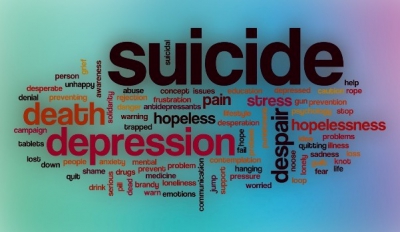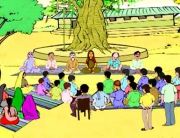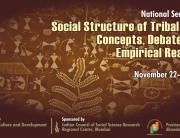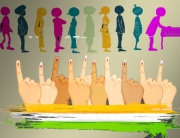Every year close to eight lakh people take their own life and there are many more who attempt suicide worldwide[1]. The mortality data about suicide available with World Health Organization (WHO) reveals that during the last several years the problem of suicide mortality has shifted from Western Europe to Eastern Europe and now seems to be shifting to Asia.[2] It is a global public health problem, particularly in Asia where high suicide rates in a few countries with large populations account for a majority of the world’s suicides.[3] For instance, almost thirty percent of all cases of suicide worldwide are committed in China and India alone.[4] Despite such compelling facts suicide receives relatively less attention in Asian countries than it does in the West, resulting in under-emphasis on related research and fragmented suicide-preventive approaches.[5],[6],[7]
In India, more than one lakh people commit suicide every year. Official records reveal that in the last ten years (2005-2015), the number of suicides have increased by seventeen percent; while for the same period the rate of suicides increased slightly by 2.9 %.[8] Regionally the trends show lower suicide rates in the less developed states (Gangetic plains, except West Bengal) while higher suicide rates in the better-developed southern states.[9] Despite rising trends in suicide, there is little systematic study of suicides and suicidal behavior in the country. Moreover, even with suicide being an increasingly complex phenomenon in modern times there are substantial work that has remained unused and unknown such as the published work on ethnography and historiography of suicides and self-immolation from 1886 to 1936.[10]
A lesser amount of academic studies on the subject is because of a challenge of studying suicide both qualitatively and quantitatively as it encompasses various socio-psychological dimensions.[11] Understanding their incidence through statistics would only give a partial understanding as they deal with reported suicide deaths. Besides, there is a great deal of evidence to suggest significant under-reporting of suicides in India and in neighboring countries like Srilanka and Pakistan.[12] Under reporting of suicides occur mainly due to its being treated as a criminal offence (until 2016)[13] and owing to social stigma. Further the fact that the implications of suicidal behavior differ depending on whether the act has been ‘suicide attempt’, ‘suicide death’ or ‘suicidal tendency’ makes it difficult to study suicides comprehensively. Victims of ‘suicide attempts’ and ‘suicidal tendencies’ suffer from acute mental and physical trauma along with the possibility of relapse of suicide attempts. In case of ‘suicide deaths’, the act may turn disturbing for family members left behind. Among some, it can give rise to psychological problems such as depression, post-traumatic stress disorder, which continued for long could make them suicide prone. It is to note that methodologically one would know about number of ‘suicide deaths’, but victims of ‘suicide attempts’ and ‘suicidal tendencies’ are difficult to count as many may not be treated in a hospital or documented in official records.
In qualitative research on suicides, there is a challenge of assessing information as well as its reliability. While those who survived suicide attempt or living with suicidal tendencies can tell their story but in cases of deaths due to suicides, one has to depend on relatives to make sense of victims’ action and the social circumstances under which the event occurred. Moreover, as the information is strictly personal, confidential with the added dimension of social stigma[14], there are chances of response being only part of complete story. It arises as sharing of information depends on person’s willingness of what and how much to reveal.[15] Such complex nature of methodological issues thus introduces complexity in observing suicides (pre and post) and associated elements in totality.
Global and Indian scenario of suicide locate suicide as an important public health issue that needs attention and prevention. It is also true that geographic, cultural, social, religious, and economic factors all interact to influence the suicide rate and shape the suicide profile of a country. Moreover, easy access to means of suicide further increases suicidal deaths. Suicidal behavior thus raises various queries such as:
- What are the factors that lead individuals towards committing suicide?
- Who are the major risk groups?
- What are the consequences of suicidal acts or tendencies on the families/friends?
- How to prevent suicidal thoughts and feelings?
It is believed that people who commit suicide are often trying to get away from the life crisis, adverse situations and difficulties that to them appear insurmountable to deal with. They may be feeling as victims of rejection, loss, or loneliness striving to get relief from guilt, shame or being a burden to others. However, there might be suicide cases that challenge this universal homogeneous presumption of suicide as a negative act. For instance, self-killing as a form of protest, as a traditional rite of attaining salvation[16] or seeking passive euthanasia[17], all underline a positive meaning for the victim. Such inferences make the subject of suicide more subjective and complex. Due to involved sensitivity and complexity, looking at suicides subjectively is a difficult task but the possibility to enrich the inherent interpretations of suicide and suicidal behavior might lie in multidisciplinary approach and explorations.[18]
Just like nature of suicidal act/ideation, the prevention of suicide is equally complex. It is though feasible but is not an easy task. It involves a whole series of activities, ranging from the environmental control of risk factors and means, through the early identification and effective treatment of people with mental and substance use disorders, to the responsible reporting of suicide in the media.[19] Considering the number of people who are in need of suicide prevention activities, appropriate dissemination of information and awareness-raising efforts are essential. All those engaged with the subject of suicide as health professionals, educators, government and non-government agencies, social workers, legal professionals and so on needs to be linked together to address the prevention of suicide along with families and communities for effective outcome.
Suicide and self-harming behavior of individuals largely surrounded by stress along with negative thoughts and feelings about themselves with the perceived inability to cope. Though they wish to die, in many cases, they just want the unbearable pain, stress, and emotions to end. One has to understand the contexts and sets of relationships within which they occur as their acts is more a socially constructed option. Other than rapid changes in economic life, especially after economic liberalization, changes in society such as family structure, marriage, social aspirations and so on also point towards emerging suicidal tendencies and deaths.[20]
For an inclusive exploration on the issue of suicide and self-harm, there is a need for a dialogue that provide multiple insights on the subject. Hence, this seminar is proposed with the following objectives:
- To understand challenges and difficulties of the subject.
- To understand trends and patterns in suicides and suicidal tendencies.
- To know various interpretations of suicides and tendencies.
- To understand the possibilities of linking various stakeholders in preventing suicide.
- To understand how in recent times mental illness is becoming an important cause of suicide owing to social stigma attached to it and how things can be shaped to remove it; and
- To understand the barriers to access mental services and treatments by suicide prone individuals and their families.
Seminar Plan and Topics
Based on Indian context papers are invited having the following broad themes:
1. Studying Suicide: Methodology and Content
- Methodology of studying suicide: Methods/ Approach
- Difficulties and Challenges of applying relevant and related methods in this field
2. Interpreting Suicides: Varying Perspectives
- Socio-Psychological Interpretation
- Biological/Genetic Interpretation
- Religious/Cultural Interpretation
- Legal Interpretation
- Suicide as a Protest
- Euthanasia: suicide or right to die with dignity
3. Risk Groups
- Adolescents, Youth, Middle-Age, Elderly
- Male, Female and others
- Students, Unemployed, Farmers, Housewives and others
- Marital Status, Caste, Religion, Class and Others
4. Factors Triggering Suicidal Tendencies
- Family Problems: Family Conflicts, Marriage Related Issues etc.
- Economic Issues: Debt, Financial loss, Unemployment, Poverty etc.
- Substance Addiction: Drugs, Alcohol etc.
- Health Issues : Mental illness, Prolonged illness
- Peer Pressure Issues: Love Failures, Academic Failures, Expectations/Aspirations Failures etc.
5. Preventing Suicide
- Role of Psychiatrists/ Mental Health Professionals
- Role of Religious organizations
- Role of local associations/volunteers/NGO’s
6. Overcoming Suicidal Feeling : A Journey of Hope and Healing
- Sharing of Personal Stories : Suicide Attempt and Suicide Loss
- Impact of suicide act/self-harm on others
- Challenges of family living with an individual with suicidal tendencies.
Unlike in the Western countries, suicides in India rests more with socio-psychological factors than biological or exclusively psychological factors. Moreover, despite the religious calling of suicide as a condemned and prohibited act and a sign of sin against their respective religious god’s, people of all religion commit suicide.[21] By bringing people from various subjects to a dialogue on the problem of suicide, we hope to learn issues and concerns linked to suicide in different contexts. We hope to come out with insights, which would enable us to enhance our understanding of suicide phenomenon.
Venue
The seminar will be held during 7th – 8th December 2018 at Centre for Culture and Development, Vadodara, Gujarat. Vadodara is well connected by rail and air network to the rest of India.
Travel Support and Accommodations
Travel fare by III AC (Railway) will be reimbursed. Accommodation and local hospitality will be provided to the delegates at the Institute guesthouse and nearby hotel/s.
[1] http://www.who.int/mediacentre/factsheets/fs398/en/
[2] Varnik, Peeter. 2012. Suicide in the World, International Journal of Environmental Research and Public Health, 9: 760-71. doi:10.3390/ijerph9030760
[3] Hendin, Herbert 2008. ‘Introduction- Suicide and Suicide Prevention in Asia’. In Herbert Hendin (et al.) Suicide and Suicide Prevention in Asia, Geneva: World Health Organization.
[4] Bertolote, M Jose and Fleishmann, A. 2002. A global perspective in the epidemiology of suicide, Suicidologi, 7 (2), pp-6-8.
[5] Yip, PSF. 2008. ‘Introduction’. In Yip PSF (ed.): Suicide in Asia: Causes and Prevention. Hong Kong, China: Hong Kong University Press, pp.1–6.
[6] Hendin, H. et al. 2008. Epidemiology of suicide in Asia. In Hendin H, Phillips MR, Vijayakumar L et.al, (eds.): Suicide and Suicide Prevention in Asia. Geneva: World Health Organization, pp: 7–18.
[7] Yip, PSF and Law YW. 2010. Towards Evidence-based Suicide Prevention Programmes. Geneva: World Health Organization.
[8] National Crime Record Bureau (NCRB). 2015. Accidental Deaths and Suicides in India. Ministry of Home Affairs, New Delhi Government of India.
[9] Reducing Suicides. (Editorial). 2016. Economic and Political Weekly, Vol. LI (52), pp-9
[10] Shah, A. M and Lobo, Lancy. 2018. Introduction. In Shah, A. M and Lobo, Lancy (Eds.): Essays on Suicide and Self-Immolation-Indian Anthropology, 1886–1936, Volume I. New Delhi: Primus Books.
[11] Borges, Guilherme; Anthony, C. James and Garrion, Z. Carol. 1995. Methodological Issues Relevant to Epidemiologic Investigations of Suicidal Behaviors of Adolescents, Epidemiologic Reviews, 17 (1), pp. 228–239.
[12] Gajalakshmi, Vendhan and Peto, Richard. 2007. Suicide Rates in Rural Tamil Nadu, South India: Verbal Autopsy of 30,000 Deaths in 1997-98, International Journal of Epidemiology, 36 (1), pp. 203-07.
[13] Indian government have now decriminalized the suicide act. As per ‘The Mental Healthcare Act, 2017’, suicide is no more a crime. It considers suicidal persons as suffering from mental illness and states government to make efforts to protect and provide them mental healthcare and services.<.
[14] Minayo, M. C. D’Souza; Cavalcante, G Fátima; Ramos de Souza, E. 2006. Methodological Proposal for Studying Suicide as a Complex Phenomenon, Cad. Saúde Pública, Rio de Janeiro, 22(8), pp. 1587-1596.
[15] Lobo, Lancy and Bharati, Kanchan. 2018. ‘Suicidal Trends and Tendencies with their Socio-Economic and Psychological Determinants in Gujarat: A Pilot Study of Vadodara District’, Centre for Culture and Development, Vadodara.
[16] Staples, James. 2012. Introduction: Suicide in South Asia: Ethnographic Perspective, Contributions to Indian Sociology, 46 (1 and 2), pp.1-28.
[17] Passive euthanasia is a condition where there is withdrawal of medical treatment with the deliberate intention to hasten the death of a terminally ill patient. In March 2018, Supreme Court of India, passed judgment for the permission of passive euthanasia through living wills outlining whether or not a person want his/her life to be artificially prolonged in the event of a devastating illness or injury.
[18] Staples, James. 2012. Introduction: Suicide in South Asia: Ethnographic Perspective, Contributions to Indian Sociology, 46 (1 and 2), pp.1-28.
[19] Hendin, Herbert. 2008. ‘Introduction: Suicide and Suicide Prevention in Asia’. In Herbert Hendin (et al.) Suicide and Suicide Prevention in.Asia, Geneva: World Health Organization:
[20] Reducing Suicides. (Editorial). 2016. Economic and Political Weekly, Vol. LI (52), pp-9
[21] Deeptiman, Tiwari. 2016. NCRB figures show highest suicide rates among Christians, Dalits and Tribals, Indian Exp., June 5.
Unreleased data on India by National Crime Record Bureau[21] (NCRB) highlighted the suicides among dominant religion in India. According to the report for the year 2014 Christians who constitute only 2.3 % population, had suicide rate of 17 as compared to Hindus at 11.3 per lakh population. The rates for both communities were above the national average of 10 per lakh population for the year. The corresponding suicide rates among Muslims and Sikhs were however much lower.







Add Comment